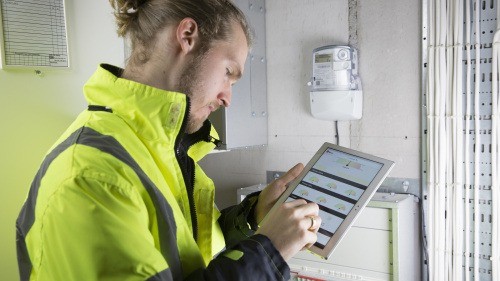By Stefan Berggren , Senior Product Marketing Manager, Product Strategy Short Range Radio and Ludger Boeggering, Senior Professional Market Development – Product Strategy, Product Center Cellular, u blox
Consumers and utilities alike stand to gain from the short range technology that is already universally present in our pockets.
Smart meters play a key enabling role in the digital transformation of cities. Without smart meters, it’s difficult to envisage many of the smart utilities and services that promise to make tomorrow’s cities so appealing: improved resource efficiency, increased capacity for renewable energy sources, better management of public utilities, and increased overall resilience at the urban scale. To learn more already, watch our Webinar:
Already today, smart meters are deployed in buildings around the world. Once set up, they automatically measure electricity, gas, heat, and water consumption, enable automated billing, consumption tracking, and reduce fraud. For consumers, smart meters can spell increased convenience and, potentially, savings. For utilities, the payback comes in form of improved infrastructure awareness, reduced waste, and more accurate control of network distribution.
Manual metering reading is on the way out. In some places it’s already phased out, to the point that you may not even recall the last time you opened your door to a meter reader. That’s largely because utilities have rolled out a broad range of wired and radio‑frequency‑based communication technologies to access the information without having to physically enter your premises.
More recently, cellular technologies including 2G and 3G have seen a surge in their uptake. Quick to set up and simple to maintain and roll out, they seamlessly transmit meter readings to utility providers, leveraging public cellular networks The introduction of 5G‑ready low power wide area technologies such as LTE‑M and NB‑IoT are adding to that momentum, on the back of long battery lives, extensive geographical coverage even underground, low‑cost hardware, and cheap data plans they offer.
Problem solved?
When developing and deploying smart metering solutions, the choice of communication technology needs to be made judiciously. Technologies need to be optimized for the specific use case and setting they will be used in to ensure that they perform reliably without congesting cellular networks. Cellular communication technologies are ideal for enabling point‑to‑point communication. In dense deployments such as inside residential apartment buildings, mesh technologies have their advantages. And short range technologies are the obvious choice when it comes to wirelessly communicating with individual meters, be it for monitoring or configuration.
Bluetooth® technology is establishing itself as a compelling short range technology choice for these types of use cases. Bluetooth mesh, which is operational on Bluetooth 4.0 and higher, enables device to device communication across a network, allowing data to hop from sensor to sensor across a building to a centralized smart meter. Alternatively, the mesh network can be connected to a cellular gateway – either a separate unit or implemented on the smart meter itself – from where meter readings can be transferred the cloud. Combining cellular and short range technologies in this way allows for interesting new use cases such as smart heat cost allocators.
Deploying a cellular gateway in a residential building also gives utility providers new opportunities to expand their service offering. They can, for example, let tenants take advantage of the reliably maintained cellular connection to connect smart home sensors, devices, and appliances to the cloud, and enable additional services, such as alerting users in the event of indoor leaks. In addition to generating new revenue streams, this gives utilities an opportunity to deepen their customer relationships.
Simplifying maintenance and operation
We’ve come to expect that there’s an app for everything, so why should smart meters be any different? Because virtually all modern connected devices – in particular our smartphones – feature Bluetooth connectivity out of the box, this presents an opportunity for metering companies to offer their consumers an easy‑to‑use graphical user interface to monitor their water, gas, heat, or power consumption. Similarly, utility providers can seize this opportunity to develop tools to wirelessly configure smart meters from a short distance and collect data from outside the apartment (rather than inside).
To learn more about the trends driving smart metering and why an approach combining cellular and short range technologies might be the way to go, be sure to watch our extensive on‑demand webinar, hosted by two of our in‑house smart metering experts. The webinar focuses on:
- Market trends and requirements,
2. Transition drivers and dependencies,
3. Architecture implementations and standards,
4. Wireless communication technologies and trials,
5. Selection criteria in key use cases.







